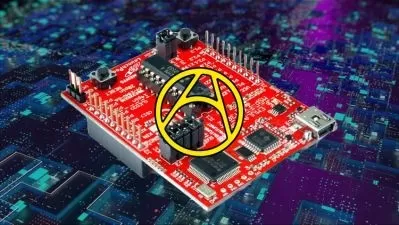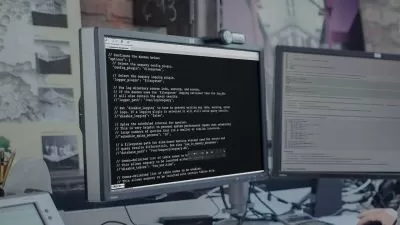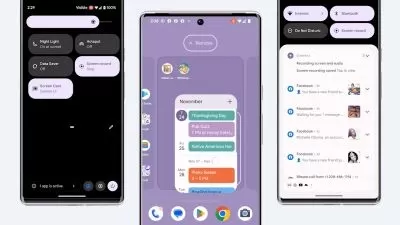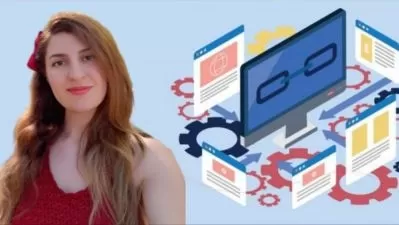Embedded Systems and OS Development
Victor Huerlimann
10:48:48
Description
Become an Expert in Embedded Systems: Develop your own OS in the C and Assembly Languages, and Design your own PCB
What You'll Learn?
- Learn how to build an embedded system from the ground up on the bench. This will give you a great insight into the target platform, but is not mandatory
- Learn how to program a microcontroller from scratch by setting up wiring, clocking, connecting the programmer, and flashing binary applications to the chip
- Get a deep insight into what an operating system is, when you need one, and how it works on embedded platforms
- Understand Kernels, Multitasking, Context Switching, Scheduling, Critical Sections, and Task Synchronization from a practical perspective
- Understand CPU Architectures in general and how to choose a target CPU. Deep understanding of the MIPS32 Arch internals, like Registers and Memory Layout
- Programming of Advanced Applications for the Microchip PIC32 (MIPS32) microcontroller
- Develop Board Support Packages (BSP) for a Target Platform
- Deep and practical understanding of data communication over the SPI and I2C busses, as well as serial communication via UART modules (including USB-to-Serial)
- Learn how to develop a Preemptive and Cooperative Kernel based on CPU-specific assembly code for Task Context Switching
- Learn how to provide efficient internal services for Time, Task, and Memory Management
- Learn how to create Inter-Process Communication (IPC) with Mailboxes and Message Queues
- Get a deep understanding of - and learn how to implement - Real-Time Constraints in order for an operating system to be considered an RTOS (Real-Time OS)
- Understand the Priority Inversion problem and learn how to implement specific countermeasures
- Learn Device Driver development. We will develop drivers step by step for our Target Platform's peripherals, such as the display and the MicroSD card
- Interfacing User Application to the OS
- Understand how to write a binary image to the Target Platform's Program Flash at runtime, and create a USB/UART Bootloader
- Learn how to make a Porting of the OS, making it executable on different CPU Architectures
- Understanding of the Target Platform's Electrical Schematic and PCB Layout (optional)
Who is this for?
What You Need to Know?
More details
DescriptionIn this course you will learn how to create an Embedded OS, really from the ground up.
You will be guided step by step in the creation of each and every technical software module composing an embedded operating system, as well as in the development of your own target device on the bench (optional: you can use a free simulator or a ready-to-use Starter Kit), starting with basic electronic components and an industry-standard processor.
You will learn how to create device drivers step-by-step for real hardware components like displays, SD card storage, Wi-Fi, Inertial Movement Units (IMU, i.e. accelerometer and gyroscope), USB communication, analog Joysticks, thermal camera modules and more.
By the end of this course you will master system-level programming in the assembly and C languages, as well as the technical processes governing the interaction between CPU and memory. Thanks to the numerous hands-on experiences and practical demonstrations, you will develop the ability of gaining full control on the machine by manipulating CPU registers, stack, instruction pointer, return addresses, and much more. At the end of the software development part, you will learn how to create a porting to another architecture, like x86.
Although the hardware development part is optional, if you have access to an electronics lab you will also develop the ability of prototyping your circuit, designing and assembling your own target PCB (Printed Circuit Board).
Who this course is for:
- From embedded developers to hobbyists and enthusiasts who are willing to create their own Operating System.
- This course is hands-on: you will be guided step by step through the creation of a working Operating System, from the ground up.
In this course you will learn how to create an Embedded OS, really from the ground up.
You will be guided step by step in the creation of each and every technical software module composing an embedded operating system, as well as in the development of your own target device on the bench (optional: you can use a free simulator or a ready-to-use Starter Kit), starting with basic electronic components and an industry-standard processor.
You will learn how to create device drivers step-by-step for real hardware components like displays, SD card storage, Wi-Fi, Inertial Movement Units (IMU, i.e. accelerometer and gyroscope), USB communication, analog Joysticks, thermal camera modules and more.
By the end of this course you will master system-level programming in the assembly and C languages, as well as the technical processes governing the interaction between CPU and memory. Thanks to the numerous hands-on experiences and practical demonstrations, you will develop the ability of gaining full control on the machine by manipulating CPU registers, stack, instruction pointer, return addresses, and much more. At the end of the software development part, you will learn how to create a porting to another architecture, like x86.
Although the hardware development part is optional, if you have access to an electronics lab you will also develop the ability of prototyping your circuit, designing and assembling your own target PCB (Printed Circuit Board).
Who this course is for:
- From embedded developers to hobbyists and enthusiasts who are willing to create their own Operating System.
- This course is hands-on: you will be guided step by step through the creation of a working Operating System, from the ground up.
User Reviews
Rating
Victor Huerlimann
Instructor's Courses
Udemy
View courses Udemy- language english
- Training sessions 52
- duration 10:48:48
- Release Date 2023/06/11
















